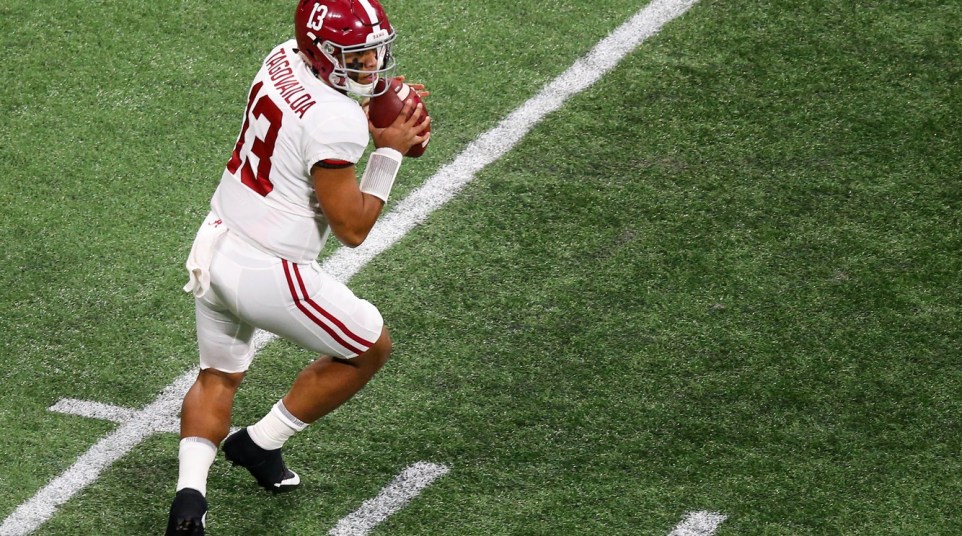
Alabama could have its most prolific passing attack of the Nick Saban era. Here's what that would look like
Conservative. Limited. Predictable.
Those are negative, but fair adjectives to describe the Alabama passing game for the majority of the Nick Saban era. Of course, that hasn’t exactly held the Tide back from winning national titles in 5 of the past 9 years. While those three words aren’t exactly flattering, there’s probably a few other words that could describe the Alabama passing game under Saban.
Efficient. Calculated. Complementary.
It makes sense. When a team runs the ball and plays defense like Alabama, why put it up for grabs if you don’t have to? It’s a basic football strategy that predates Bear Bryant.
Sure, Alabama’s passing game has had some nice jolts over the years. AJ McCarron was more than just the dreaded “game manager,” and Lane Kiffin helped take the Tide offense into the 21st century.
Now, with Tua Tagovailoa expected to start under center (at least I expect him to), it feels like Alabama is capable of turning a new leaf with its passing game. That’s not a knock on Jalen Hurts, who has proven he’s the superior rushing quarterback to Tagovailoa. But with Tagovailoa, he has already proven that his passing game potential is greater than Hurts, or perhaps any Alabama quarterback who came before him in the Saban era.
Is that theory based in large part on the last play we saw from Tagovailoa? Absolutely. Second-and-26 will live on as the most memorable play to ever end a national title game. But it’ll also be remembered as the play that opened the door for the Alabama passing game.

Credit: Mark J. Rebilas-USA TODAY Sports
Assuming that Tagovailoa is indeed the starter, it’s safe to say Alabama will finish better than No. 91 in passing offense, which was where ended last year. That’s not to say Alabama is going to suddenly turn into Texas Tech. Damien Harris and Najee Harris will get plenty of work out of the backfield, and Tagovailoa will get opportunities to make plays with his legs.
Alabama might not necessarily need to pass, but if it can keep defenses honest and lead to even more lopsided victories, why not? Keep in mind that while the Tide won it all last year, it was held to 31 points or fewer in each of its final 5 matchups vs. Power 5 teams.
The 2018 passing game has the ability to change that. It can also change the trend that the Tide’s passing game is most prolific out of necessity and not by choice.
Not surprisingly, notice which seasons Alabama put up its best passing numbers:
[table “” not found /]
Yes, the “disastrous” 2010 season fittingly forced Alabama to throw the ball more than usual. To the Tide’s credit that year, the passing game was actually extremely efficient with a Saban-era best 69.9 completion percentage and 9.38 yards per attempt (that was fifth in FBS).
There was also the 2014 season with Kiffin when the program had more weaknesses than usual by Saban standards, and the Tide threw the ball 32.2 times per game. That year yielded the high for passing yards per game during the Saban era (277.9), which was good for No. 28 nationally.
What was the common denominator in those 2 pass-happy seasons? Alabama didn’t even reach the national championship.
This year, Tagovailoa’s arm could easily be the driving force behind a title push.
Obviously the sample size is still small. Teams will be more prepared for Tagovailoa than Georgia was last year. Still, though. Against one of the nation’s top defenses in his first meaningful reps, Tagovailoa threw for 166 yards and 3 touchdowns in a half plus overtime. It wasn’t the most efficient performance (6.91 yards per attempt and 58 percent passing), but a 26-point second half speaks for itself.
So what kind of numbers can Tagovailoa put up in a full season? That’s an interesting question because I think even if he’s not as accurate as Hurts, Tagovailoa should still complete a whole lot more than 11 passes per game. And yeah, he’ll also exceed Hurts’ 1 interception from last year. You take the good with the bad with Tagovailoa because the good can be very, very good.
I don’t think it’s crazy to suggest that Tagovailoa pushes for Blake Sims’ single-season Alabama passing record of 3,487 yards. If Alabama wins an SEC title and plays 15 games, 3,500 passing yards averages out to 233.3 passing yards per game. As long as Saban doesn’t try to use a 2-quarterback system, which he seems opposed to, that’s not that bold of a prediction.
Perhaps Tagovailoa could even break McCarron’s program record of 30 touchdown passes in a season. That’s only averaging 2 per game if Alabama plays 15. I mean, Tagovailoa did throw 11 touchdown passes on just 77 attempts last year. That’s an absurd, unsustainable rate, but nothing suggests that number will fall off a cliff.
The expectation is that even without Calvin Ridley, Tagovailoa will maximize the potential of young receivers like Jerry Jeudy, Henry Ruggs III and DeVonta Smith, which Hurts failed to do in 2017.
The great question is how much trust will be put in Tagovailoa. Say what you want about Brian Daboll’s play-calling with Hurts, but Tagovailoa was turned loose in that title game. Part of that was game flow, necessity. A lot of that was ability.
Will new offensive coordinator Mike Locksley follow that same philosophy? It’s certainly possible. It’s an offensive coordinator’s job to play to the strengths of the offense, and Alabama has never had passing strength quite like this.
If Tagovailoa continues to make it look easy, we could have some new words to describe the Tide’s passing game.
Explosive. Dynamic. Prolific.
Historic.
